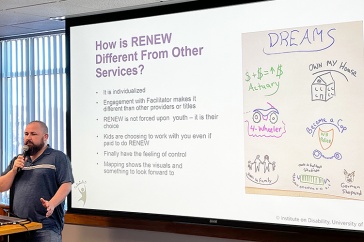
When Antonio Serna ’22, ‘23G enrolled in the undergraduate social work program at UNH, he knew he wanted to be involved in system change to create structural opportunities for lower-income people. That spark of interest, combined with his motivation to provide opportunity for New Hampshire’s more vulnerable residents, put him on a college journey that is setting him up for a rewarding career in policy and advocacy.
Over the course of his college career, Serna’s interests have centered in on affordable housing access. The Hudson, New Hampshire native became interested in that area of economic policy after he took what he was learning in class and applied it to his home town.
“I was really struck when I went home [from UNH] and saw that Hudson was less developed than other communities, and I wondered why that was,” he says. “I knew it would be interesting to look at and I decided to focus on community development in relation to housing and homelessness.”
Serna, who is also enrolled in the accelerated master of public policy program at UNH’s Carsey School of Public Policy, completed an internship with the Workforce Housing Coalition of the Greater Seacoast during his senior year in the social work program. His research, which focused on the New Hampshire towns of Dover, Exeter and Hudson, is published on their website.
Q: Please describe your research in nontechnical language.
My research started with a simple question: What are the barriers to workforce housing development within the local approval process? Based on general demographic data, I identified three communities that were different from one another in size, housing stock, median household income and housing affordability. After identifying those communities, I reached out to a planning official in each of those towns, as well as a developer of a Low-Income Housing Tax Credit (LIHTC)-supported development. I contacted and interviewed 6 professionals about their experiences in the local approval process. The questions were geared around their experiences with the approval process, some strengths and challenges within this process, and how they decide on what communities to invest in. I then conducted a thematic analysis of my findings from the interviews to identify specific commonalities between the individuals’ experiences, which were organized into 5 distinct groups: NIMBY(not-in-my-back-yard)-ism/General Attitudes; Land Use Regulations; Capacity; Time; and Cost. After identifying these groups, I sought to establish relationships between them and how they affect workforce housing development.
Q: What were the most interesting findings from your research?
One of the more interesting findings is that both developers and planning officials agree on how local land use regulations are impacting workforce housing development. This finding is interesting because it allows for greater opportunity for collaborative work between planning officials and developers. Collaboration was found to be a key condition for workforce housing development, so having developers and planning officials who are on the same page means that they can work together to create solutions for the vitality of their community. Another interesting finding was the degree to which a municipality’s capacity affected its ability to amend land use regulations or assess its housing stock. Even a one-person difference in the number of professional planning staff can determine how effectively a municipality can address regulatory needs. Most interesting is how each finding is part of an interconnected relationship, with political will and regulatory opportunity influencing the conditions for housing development.
Q: Why is this research important?
New Hampshire is facing a housing crisis characterized by low vacancy rates for rental properties and ever-rising costs for rental and for-purchase homes. This crisis is affecting workforce attraction and retention, with businesses having difficulty finding employees. In addition, New Hampshire’s housing crisis is negatively impacting lower income individuals and families looking for affordable housing, older adults looking to downsize for retirement, young couples looking to start a family and careers in New Hampshire, and countless others. My research highlights why this problem exists and how to create a greater opportunity for some of our more vulnerable neighbors. If New Hampshire residents want to see their communities grow, then they have to both 1) want workforce housing development and 2) change land use regulations to allow for and incentivize it. Housing affordability impacts us all, and it’s going to take a strong, collective effort to avoid the consequences of inaction.
-
Written By:
Callie Carr | UNH College of Health and Human Services | callie.carr@unh.edu | 603-862-0970

















































